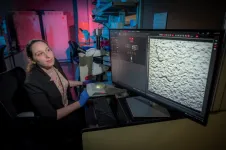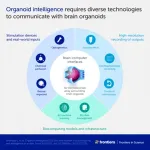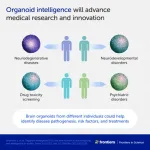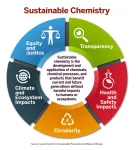(Press-News.org) AUGUSTA, Ga. (Feb. 28, 2023) – A tiny worm called the C. elegans is enabling scientists to explore the emerging theory that Parkinson’s disease starts in the gut.
Key to the condition known to produce uncontrollable shaking, but also characterized by cognitive problems and gastrointestinal distresses like constipation, is a sticky, toxic form of the protein alpha-synuclein, which literally gums up the works of our neurons and kills them.
Although it may seem counterintuitive, there is evidence from science labs like Neuroscientist Danielle Mor’s, PhD, that the toxic protein aggregates in the neurons in the gut before it interferes with neurons in the brain. The collection of destructive alpha-synuclein, called Lewy bodies, also has been found on autopsy in neurons embedded in the wall of the gastrointestinal tract of patients with early Parkinson’s.
“This is now a hot area of research,” says Mor, a faculty member in the Department of Neuroscience and Regenerative Medicine at the Medical College of Georgia at Augusta University. “I think we need to be intervening at the stage of the gut and that is honestly pretty exciting.”
It’s known that neurons in the gut regularly communicate with those in the brain and vice versa but just how the alpha-synuclein gets messed up in both is another uncertainty.
Still in animal models, scientists like Mor have watched the sticky wads get spit out of one neuron and get taken up by the next. They’ve also watched the sticky wads in the gut travel up the spinal cord into the brain. It appears this unfortunate sharing occurs primarily between neurons that already connect and communicate, says Mor.
She just received a two-year $400,000 Early-Investigator Research Award from the U.S. Department of Defense that is helping her learn more about the effects of gut-derived alpha-synuclein on cognition, how it gets inside neurons and whether there are existing drugs that can deter the cognitive impact.
Mor is among the first scientists to look at how alpha-synuclein in the gut affects cognition. And the transparent-throughout-life C. elegans are a great model for pursuing answers, Mor says.
These nematodes, or roundworms, despite their size of about .039 inches, have a gene number and gene pool similar to humans. They also have a digestive tract and many of the same neurotransmitters as humans. Neurotransmitters are chemical messengers that enable neurons to communicate like acetylcholine, associated with memory and learning, and dopamine, which is involved in helping you feel positive emotions like satisfaction and pleasure and helping us plan our movement. Dopamine is known to be substantially depleted in Parkinson’s. In fact, a healthy balance between dopamine and acetylcholine is thought to be lost in Parkinson’s and to play a major role in the uncontrolled movement that typically characterizes the condition. The death of neurons that produce dopamine is a major focus in Parkinson’s research.
Also, like humans the worms have an alimentary nervous system, which is basically a network of neurons in the gut that coordinate functions like digestion and nutrient absorption, and where Mor thinks the early alpha-synuclein first congregates and why she developed her worm models.
“Here we have new models, we are modeling gut-to-brain alpha-synuclein transmission, which we believe is one potential way that this disease occurs in humans and now we will test cognitive function. Now we will test learning and memory in these worms,” Mor says.
Previous worm models for Parkinson’s have the worms expressing human alpha-synuclein in the neurons in the brain. Mor decided to start by feeding a toxic version of the human protein to the worms. She saw it spread to the brain and the resulting degeneration of dopamine neurons in the worms’ brains over just a few days.
“I have seen that it spreads to their different body tissues, and I have seen the neurons degenerating and I have seen the worm have motor problems in a matter of days,” Mor says. She notes that a few days is a long time for the worms whose lifespan is just two to four weeks.
For the newly funded studies, she is focusing on the cognitive problems that often surface later in Parkinson’s. So as the destructive alpha-synuclein travels from gut to brain she is testing learning and memory in the worms, which she says, again seemingly counterintuitively, is not that tough to do.
“They can learn association between a lot of different things,” Mor says. In this case she is focusing on associating a strong, perfumy odor with food. Butanone, a colorless organic compound often used as an industrial solvent, provides the odor and bacteria is a favorite worm food. The C. elegans make the association in about an hour but it’s a short-term memory.
“Once they associate that odor with food they move toward that odor,” she says. “That is how we give them the quiz.” One of the questions she wants to answer is whether feeding the worms the protein aggregate she’s watched travel to the brain reduces their association and their scores.
She also wants to better understand how alpha-synuclein gets inside neurons in the gut. There is some evidence, at least in culture, that the toxic protein binds to a sugar coating on the cells, called proteoglycans, which works like a receptor and the alpha-synuclein gets taken up by that unsuspecting neuron.
She’s already knocked down a few genes in the pathway that makes the sugar coating, which reduced destruction of dopamine neurons and alleviated some of the disease symptoms in the worms.
“We think we are blocking alpha-synuclein from actually getting into the cells,” Mor says, and now her lab is looking more directly at whether that is correct. Right now, they are knocking down 17 genes related to proteoglycans that they suspect as playing a role to begin to identify the ones that actually do.
To speed the identification of drugs that might help and getting that help to people, she is doing high throughput screening of drugs already out there and approved by the Food and Drug Administration. Rather than targeting alpha-synuclein, she wants drugs that will help correct the downstream toxicity of the protein that disrupts normal neuron metabolism and function and ultimately leads to their death.
“We think cellular metabolism is a key feature of how the neurons are dying,” Mor says. She notes that others are conducting monoclonal antibody studies against the protein itself, but the results are not yet known.
Her new worm models are complementary to existing mouse models developed with this gut-to-brain approach but unlike these mouse models, her worm model is faster for the large-scale manipulations needed at this juncture to parse the problem, she says.
Although the usual role of alpha-synuclein is not crystal clear, neurons naturally have a lot of the protein, which appears to have an important role in maintaining biological suitcases called vesicles, that in this case help neurons communicate, and neurons do a lot of communicating.
The path of “gut to brain” in Parkinson’s is consistent with exposures to environmental toxins in the food or water or in warzones or from other occupational exposures. “We should know if we are endangering ourselves and right now, we don’t know,” Mor says.
Another possibility is that the gut microbiome, which has important functions like helping regulate metabolism and our immune response in addition to helping digest food, could get out of balance by the food we eat or medicines we take or even stress. The reality is there could be multiple ways alpha-synuclein becomes problematic, she says.
Cognitive decline in patients tends to occur later in Parkinson’s and has a high degree of variability. Loss of smell and sleep problems are other symptoms.
Physician Scientist Chandramohan Wakade, MBBS, associate dean of research in the AU College of Allied Health Sciences, and Erhard Bieberich, PhD, biochemist at the University of Kentucky College of Medicine, are mentors for Mor on the new grant.
END
Tiny worm plays a big role in learning whether Parkinson’s really starts in the gut
2023-02-28
ELSE PRESS RELEASES FROM THIS DATE:
Gun violence spills into new neighborhoods as gentrification displaces drug crime, according to WVU study
2023-02-27
Gentrification doesn’t erase drug crime and gun violence. Instead, research from West Virginia University economist Zachary Porreca shows that when one urban block becomes upwardly mobile, organized criminal activity surges outward to surrounding blocks, escalating the violence in the process.
Porreca, a WVU doctoral student in the John Chambers College of Business and Economics, analyzed 2011-2020 data on shootings and real estate across various Philadelphia neighborhoods. His paper presenting the findings, published in the Journal of Economic Behavior and Organization, is one of the first of its kind to study the impact of gentrification ...
Astronomers discover metal-rich galaxies in early universe
2023-02-27
ITHACA, N.Y. – While analyzing data from the first images of a well-known early galaxy taken by NASA’s James Webb Space Telescope (JWST), Cornell University astronomers discovered a companion galaxy previously hidden behind the light of the foreground galaxy — one that surprisingly seems to have already hosted multiple generations of stars despite its young age, estimated at 1.4 billion years old.
“We found this galaxy to be super-chemically abundant, something none of us expected,” said Bo Peng, a doctoral student in astronomy, ...
Climate trends in the west, today and 11,000 years ago
2023-02-27
People often say things like Phoenix has always been dry; Seattle has always been wet; and San Francisco has always been foggy. But “always” is a strong word.
A study from the University of California, Davis, synthesizes climate trends across the Western U.S. during a relatively young period of Earth’s history — the Holocene Era, which stretches from the present day to the past 11,000 years. This look at the really Old West shows that the hallmarks of California’s climate — the foggy coastlines ...
Mysteries of the Earth: FSU researchers predict how fast ancient magma ocean solidified
2023-02-27
Early in the formation of Earth, an ocean of magma covered the planet’s surface and stretched thousands of miles deep into its core. The rate at which that “magma ocean” cooled affected the formation of the distinct layering within the Earth and the chemical makeup of those layers.
Previous research estimated that it took hundreds of million years for that magma ocean to solidify, but new research from Florida State University published in Nature Communications narrows these large uncertainties down to less than just a couple of million years.
“This magma ocean has been an important part of Earth’s history, and this study helps us answer ...
The Texas Heart Institute delivers a new first in heart failure treatment using cell therapy
2023-02-27
Houston, TX – February 27, 2023 – Physician-scientists at The Texas Heart Institute announced today the results of the largest cell therapy trial to date in patients with chronic heart failure due to low ejection fraction. The therapy benefited patients by improving the heart’s pumping ability, as measured by ejection fraction, and reducing the risk of heart attack or stroke, especially in patients who have high levels of inflammation. Also, a strong signal was found in the reduction of cardiovascular death in patients treated with cells. The findings ...
Augmented reality headset enables users to see hidden objects
2023-02-27
MIT researchers have built an augmented reality headset that gives the wearer X-ray vision.
The headset combines computer vision and wireless perception to automatically locate a specific item that is hidden from view, perhaps inside a box or under a pile, and then guide the user to retrieve it.
The system utilizes radio frequency (RF) signals, which can pass through common materials like cardboard boxes, plastic containers, or wooden dividers, to find hidden items that have been labeled with RFID tags, which reflect ...
How common is face blindness?
2023-02-27
How Common Is Face Blindness?
Study suggests condition affects more people than previously thought
For Immediate Release
Media Contacts:
Dennis Nealon
Dennis_Nealon@hms.harvard.edu
508-494-6117
Ekaterina Pesheva
Ekaterina_Pesheva@hms.harvard.edu
617-432-0441
At a Glance:
Study by researchers at Harvard Medical School/VA Boston Healthcare System suggests that face blindness lies on a continuum and may be more common than currently believed.
The study found similar face matching performance between prosopagnosics diagnosed with stricter vs. looser criteria, suggesting that the diagnostic criteria should be expanded.
As many as ...
Midwifery care safe for moderate- and high-risk pregnancies
2023-02-27
New UBC research shows that midwives in British Columbia are providing safe primary care for pregnancies of all medical risk levels, contrary to a popular belief that midwives mostly manage low-risk pregnancies.
The study, published in the Canadian Medical Association Journal, examined a decade of births in B.C. between 2008 and 2018. The researchers compared birth outcomes for people who had a midwife as their most responsible provider (MRP), with those who were cared for by a family physician or obstetrician.
The findings reveal that people who had a ...
Sustainable chemistry experts create blueprint for safer future
2023-02-27
Feb. 27, 2023
Media contacts:
Emily Gowdey-Backus, director of media relations, Emily_GowdeyBackus@uml.edu
Nancy Cicco, assistant director of media relations, Nancy_Cicco@uml.edu
Sustainable chemistry experts create blueprint for safer future
Group to share its work during free UMass Lowell webinar on March 1
Toxic chemicals – which pop up in everything from household cleaners and appliances to medical devices, paints, packaging and more – are all around. The February ...
Early-life stress can disrupt maturation of brain’s reward circuits, promoting disorders
2023-02-27
Irvine, Calif., Feb. 27, 2023 — A new brain connection discovered by University of California, Irvine researchers can explain how early-life stress and adversity trigger disrupted operation of the brain’s reward circuit, offering a new therapeutic target for treating mental illness. Impaired function of this circuit is thought to underlie several major disorders, such as depression, substance abuse and excessive risk-taking.
In an article recently published online in Nature Communications, Dr. Tallie Z. Baram, senior author and UCI Donald Bren Professor and Distinguished Professor in the Departments of Anatomy & Neurobiology, ...








